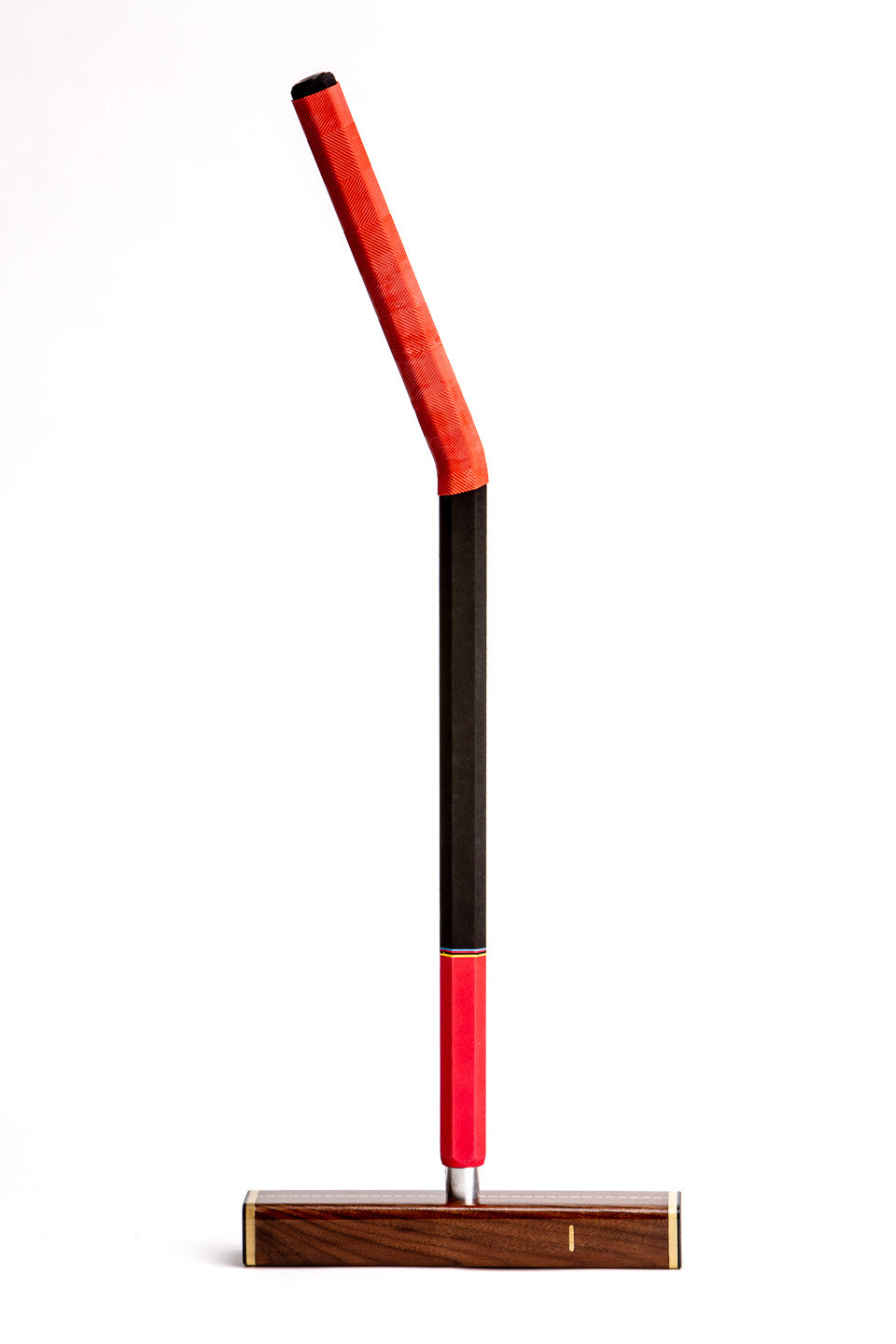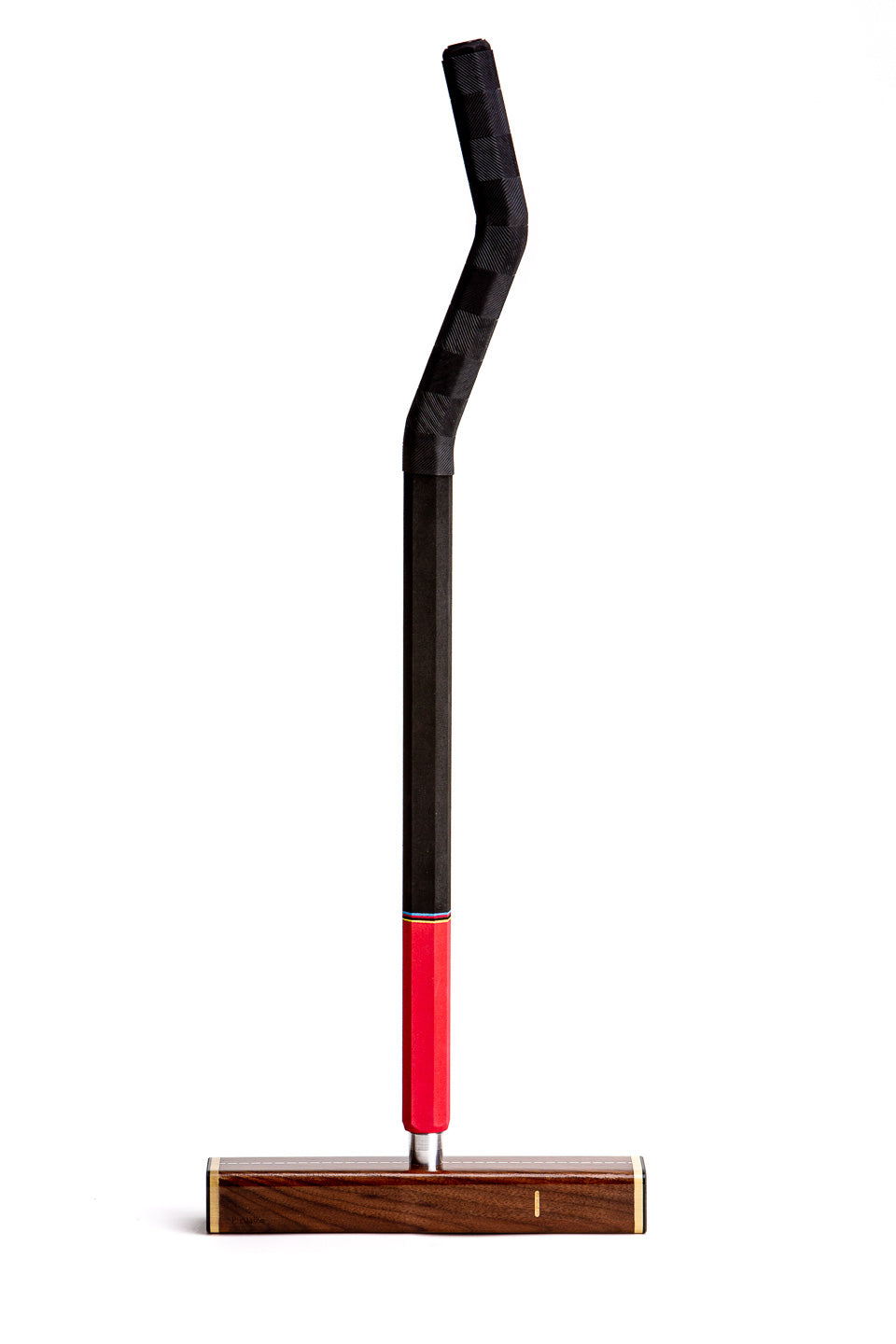Bent shaft primer
Over 30 years ago, when I first started making croquet mallets, I thought “this is the most awkward piece of sports equipment I’ve ever held. But I’m a mallet-maker, so it shouldn’t be a problem.” Best described, at the moment of impact, the player’s wrists are hyper-extended when using a straight handle. Ideally, that’s the moment when the wrists should be in a relaxed (ie: straight) position. Reducing stress or muscle tension helps the player relax and perform at their optimum.
Fast forward about 15 years, a player came to me, explaining how his Irish grip was challenging when he was looking for increased power WHILE maintaining control. After some thought, the conclusion was to ‘bend’ the carbon fibre handle on his mallet. Although our journey started with the challenges faced by Irish grip players, those same issues are present with the Standard and Solomon grips.
The process of bending involved 3 main challenges:
- How to bend the shaft while maintaining the strength and light weight qualities of the carbon fibre handle
- Determine the optimum angle to bend the handle
- How to install our comfort foam grip over the bent carbon tube
Bending a carbon tube seemed to be a daunting process and possibly an expensive one. No one had ever made a bent carbon fibre handle when we began this project. We learned early on that molding a single piece carbon tube into a bent shape was prohibitively expensive. The only other option was to create a multi-piece tube. A variety of materials & processes were experimented with, before landing on the right combination.
Determining the optimum angle was the next challenge. The goal was to bend the handle so the player’s wrists are in a straight & relaxed orientation at the point of contact with the ball. Interestingly, it turns out that it’s the same angle, regardless of which grip is employed, forward or backward.
Installing our comfort foam grip over the bent carbon fibre skeleton wasn’t a simple matter in the beginning. Our first generation was a segmented foam grip over the multi-piece skeleton. Our team, though, was up to the challenge. Sometimes the answers come from the most unlikely places. A question to one of our production team members by our office lady about something different, turned out to be the inspiration to create the process. Our bent shafts now feature a one-piece foam grip on a bent carbon fibre skeleton.
Note: One of the side benefits to the bent shafts was pointed out by several people who simply pointed to the inside base of their thumb. Their comment was, "It no longer hurts here." The big smile on their face said it all.
Which bend is right for me?
Warning! Bent handles are not meant for new players. New players are learning a new set of skills, including the most comfortable hand orientation. It’s not unusual for a novice to start out with one grip then try alternate grips. Once you’ve decided on a grip, only then should you consider a bent handle. It is your grip that determines which bend you need.
 Single bend handles cater to both Irish and Solomon grips because these orient your hands in a single direction. However, the bend faces in opposite directions with each. With an Irish grip, the shaft bends toward the player. Solomon grip players will face the bend away from them. If you get either of these backward, you’ll very quickly know it. Rather than relaxing your wrists into a straight line, you’d be contorting your hands into an almost impossible position.
Single bend handles cater to both Irish and Solomon grips because these orient your hands in a single direction. However, the bend faces in opposite directions with each. With an Irish grip, the shaft bends toward the player. Solomon grip players will face the bend away from them. If you get either of these backward, you’ll very quickly know it. Rather than relaxing your wrists into a straight line, you’d be contorting your hands into an almost impossible position.
 For players using a Standard grip, their hands are oriented opposite to each other. On one hand, the palm faces forward while the other hand, the palm faces toward you. Because of the ‘double orientation’, a double bend handle is needed. When using the double bend handle, the top of the handle should be facing away from the player. This ensures the comfortable wrist position that the double bend handle was designed for.
For players using a Standard grip, their hands are oriented opposite to each other. On one hand, the palm faces forward while the other hand, the palm faces toward you. Because of the ‘double orientation’, a double bend handle is needed. When using the double bend handle, the top of the handle should be facing away from the player. This ensures the comfortable wrist position that the double bend handle was designed for.
Mallet height is a bit more ‘particular’ to determine with bent shafts. This is a result of the player’s hands needing to be positioned in a bent area of the shaft. Placing them anywhere else will negate the benefits of the bends. For ‘drive’ shots and all Golf croquet strokes, players are strongly encouraged to keep their hands close together. The bent sections are designed to follow that teaching. With that in mind, and including which grip style is employed, the next step is to measure the distance from the ground to the bottom of the bottom hand. This can be done with a straight shaft mallet and the player is in their normal ‘striking’ position. That determines where the first bend is positioned when the shaft is built.
Once you start playing with your new bent shaft, don’t get discouraged if your game drops for a while. It is normal, given that the muscle memory built up from years of teaching your hands & wrists using a straight handle, no longer applies. Stick with it and re-teach your hands how to play in the new positions. You’ll be glad you did.
